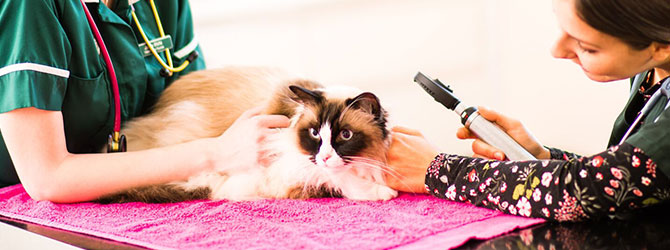Cat microchipping: how and when to get your cat microchipped
Microchipping your cat or kitten is now a legal requirement in England, but don't worry — it's a simple and pain-free procedure. During microchipping, a small chip, usually no larger than a grain of rice, is typically placed under your cat's shoulder blades. This chip contains a unique identification number for your cat.
If your cat is lost or stolen, the microchip can be scanned, and the number will show up in a system, along with your name, address, and contact details. You'll be contacted and reunited with your pet if the information is correct and up-to-date.
While it's essential for your cat also to have your contact information on their collar, microchipping is a safe and effective way of identifying them if they get lost.
Brief Summary
- Microchipping is a safe and effective way to identify cats, providing a permanent and unique form of identification.
- The microchip is a small implant that contains a unique identification number, which can be read using a scanner and matched to a database containing the owner's information.
- Microchipping is a quick and simple procedure that can be done by a veterinarian, and it is typically done while your cat is receiving their vaccinations or being spayed ot neutered.
- New legislation by the UK government in March 2023 means that all pet cats in England must be microchipped by 10 June 2024.
What is a microchip for cats?
A microchip is a small device about the size of a grain of rice that uses Radio Frequency Identification (RFID) to transmit information via radio waves. Unlike other devices that require a power source or battery, a microchip only stores information without external power. Instead, it is placed in a small, non-toxic protective case that does not harm your cat and can last their entire life.
How is a microchip implanted in my cat?
Your cat's microchip will be removed from its sterile packaging and scanned to ensure the ID is the same as on the packaging. This ensures that all the information corresponds so your cat can be identified should they go missing.
Using a syringe, your cat's microchip will be implanted beneath the skin between their shoulder blades. This will be done with your cat either lying down or stood up, and the loose skin between the shoulder will be pulled up to allow maximum room for the injection,
It is a quick and painless - apart from the actual injection - procedure, and your cat won't need any anaesthetic or pain relief during or after.
In fact, it's such a simple procedure that you won't notice any difference in your cat, and they are unlikely even to know that the microchip is there. After the injection, no recovery time is needed; they will continue to be their wonderful, weird selves.
What information is on my cat's microchip
The microchip only contains one piece of information: your cat's unique identification number. This number is linked to a microchip registry or database, which stores a range of information, including:
- Your name (the owner)
- Your home address
- Contact details (Phone number and email address)
- Pet's ID number
- Pet's name, gender and date of birth
- Their breed
- Their fur colour and if they have any identifiable markings
It's essential to keep this information up-to-date, for example, if you move house or change your phone number or email address. Failure to update your information could prevent someone from reuniting you with your cat if they become lost.
All of this information is stored within a government-approved database and can be used to identify and reunite you with your pet if they go missing.
When should I get my cat microchipped?
There's no minimum age requirement, but microchipping your cat before they go outside is a good idea. Generally, getting your cat microchipped as soon as you get them is a good idea. With kittens, this would be during their initial course of vaccinations. This way, you know it's done and have peace of mind that your cat can be reunited should they wander away.

How much does it cost to microchip a cat?
Microchips must be fitted by a professional. The cost of microchipping your cat will vary from practice to practice, but you can expect to pay between £20 and £30, although prices can vary.
Keeping the microchipping database current is essential if you move house or change your contact number. This is easy to do – call or email the database to notify them of the change. Depending on the database your cat is registered with, there may be a small admin fee.
Those pet owners struggling with the continued cost of living crisis can speak to animal charities who may offer free microchipping. In addition, other preventative healthcare plans, like Pet Health Club™, offer free microchipping when you sign up to their cat plan.
How does microchipping work?
A microchip is a tiny device, about the size of a grain of rice, that is placed under a cat's skin at the back of their neck. It's a quick, simple, and relatively painless procedure, and once the microchip is in place, it won't bother your cat.
Each microchip has a unique number stored in a database corresponding to the owner's details. So, if your cat gets lost or is stolen, scanning their microchip can help reunite you quickly.
Who can scan my cat's microchip?
If your cat has gone missing and is found, the organisation it is taken to should be able to scan their microchip. The most common places a lost cat is taken to are a vet, rescue centre, or police station.
Because your cat's microchip information is stored in a database, it can be accessed by any of these organisations, who can contact you directly.
What do I do if my cat goes missing?
If your cat goes missing, the first thing to do is locate their microchip information. This should be stored somewhere safe and is often included on a tag or card. Then you can contact your vet or police station to see if your cat has been brought in.
If they haven't, you will have to wait, but if they've been microchipped and the information is up-to-date, you can be reunited.
Do microchips really work?
Yes. There are so many stories about cats reuniting with owners after miles and years apart. One cat, Kiki the Tortoiseshell, was found 10 miles from her family home and was reunited with her owner after seven years.
Can you feel a microchip in a cat?
You can feel your cat's microchip, although this isn't recommended because you don't want their microchip to move around. It feels like a grain of rice and is located just between their shoulder blades, where it should be left.
Can my cat's microchip move or break?
Most modern microchips are coated with a polymer, or material, that forms a connective tissue when it comes into contact with your cat's muscles and tissue. This prevents it from moving.
The rates of microchip failure are around one in a million. Your vet will check your cat's microchip before and after it's implanted to ensure it works.
Do cats need to be microchipped more than once?
Your cat's microchip is designed to work for the entirety of their life, so they only need to be microchipped once.
Do cats need to be microchipped?
Yes. New legislation by the UK government in March 2023 means that all pet cats in England must be microchipped by 10 June 2024. From that date, you will have 21 days to have your cat microchipped or face a £500 fine.
Why do cats need to be microchipped?
The UK government has brought in legislation to keep the rules on cat microchipping in line with that of dogs. Environment Secretary Thérèse Coffey said legislating for compulsory microchipping of cats “will give comfort to families” by increasing the likelihood that lost or stray pets can be reunited with their owners.
Currently, there are more than nine million pet cats in the UK, and around 2.3 million of them are unchipped. That means there are 2.8 million families at risk of losing and being unable to be reunited with their pets.
Why do only cats in England need to be microchipped by law?
Only cats in England have to be microchipped by law because of what is known as devolution. This means that each country: England, Scotland, Wales and Northern Ireland, is in charge of creating their own legislation or laws, and compulsory cat microchipping falls under this category.

Common questions around microchipping cats
My cat is an indoor cat, does it still need to be microchipped?
Under the new law, all cats in England, except those that are classed as ‘free-living,’ must be microchipped. Cats that would fall into this category are those that have little or no human interaction or dependency, such as farm, feral, or community cats. Indoor cats, as entirely dependent pets, would need to be microchipped.
They should be microchipped anyway, as it is impossible to guarantee that an indoor cat will not escape. If they do, the chances of them getting lost are higher as they won’t know their area like an outdoor cat would.
Are microchips dangerous to my cat?
The simple answer here is no. Some risks, so small as to be negligible, come with microchipping. The first of these is if the chip ‘travels’ or moves. Thanks to the polymer coating of the microchip, it should bond with the tissue, which will keep it in place.
There have also been claims that microchipping causes cancer. There were two reports of cats suffering from microchip-associated tumours, and one of these had no evidence to link it to the microchip directly.
Even with these concerns, the benefits of microchipping your cat far outweigh the negatives.
The benefits of a microchip cat flap
If you’ve had your cat microchipped, you may want to install a microchip cat flap. They prevent stray and unwanted cats from entering your home by recognising the microchip number of your cat(s) and your cat(s) only!
Microchip cat flaps are more efficient than those that require your cat to wear a tag on their collar. Not to mention, wearing a tag on their collar can be uncomfortable, and there's always the chance it will come off.
Need more info?
For expert advice on microchipping your cat, get in touch with your local vet.
Find your nearest vet using our Find a Vet page, or speak to a vet online using Online Vets.





